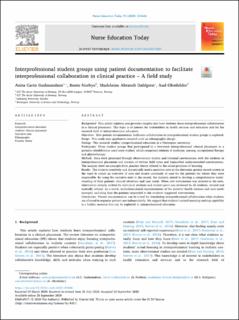| dc.contributor.author | Gudmundsen, Anita Carin | |
| dc.contributor.author | Norbye, Bente | |
| dc.contributor.author | Dahlgren, Madeleine Abrandt | |
| dc.contributor.author | Obstfelder, Aud | |
| dc.date.accessioned | 2021-01-11T13:07:20Z | |
| dc.date.available | 2021-01-11T13:07:20Z | |
| dc.date.created | 2020-10-12T11:46:56Z | |
| dc.date.issued | 2020 | |
| dc.identifier.citation | Nurse Education Today. 2020, 95 . | en_US |
| dc.identifier.issn | 0260-6917 | |
| dc.identifier.uri | https://hdl.handle.net/11250/2722401 | |
| dc.description.abstract | Background
This article explores and provides insights into how students learn interprofessional collaboration in a clinical placement. This topic is of interest for stakeholders in health services and education and for the research field of interprofessional education.
Objectives
How patient documentation facilitates collaboration in interprofessional student groups is explored.
Design
This study uses qualitative research with an ethnographic design.
Settings
This research studies interprofessional education at a Norwegian university.
Participants
Three student groups that participated in a two-week interprofessional clinical placement in a geriatric rehabilitation ward were studied, which comprised students of medicine, nursing, occupational therapy and physiotherapy.
Methods
Data were generated through observational studies and informal conversations with the students in interprofessional placement and consists of written field notes and transcribed audio-recorded conversations. The analysis drew on concepts from practice theory related to the social practices of learning.
Results
The students creatively and dynamically used a narrative note in the electronic patient record system in the ward to create an overview of care and ensure continuity of care for the patients for whom they were responsible. By using the narrative note in the record, the students aimed to develop a comprehensive understanding of their patients' clinical situations and care needs. When new information was entered in the note, information already written by individual students and student pairs was reviewed by all students, revised and mutually refined. As a result, multidimensional representations of the patients' health statuses and care needs emerged, including how the patients responded to the students' suggested interventions.
Conclusions
Patient documentation can be a tool for stimulating interprofessional collaboration when students are allowed to organize patient care independently. We suggest that students' natural meaning-seeking capability is a hidden resource that can be exploited in interprofessional education. | en_US |
| dc.language.iso | eng | en_US |
| dc.publisher | Elsevier | en_US |
| dc.rights | Navngivelse 4.0 Internasjonal | * |
| dc.rights.uri | http://creativecommons.org/licenses/by/4.0/deed.no | * |
| dc.title | Interprofessional student groups using patient documentation to facilitate interprofessional collaboration in clinical practice - A field study | en_US |
| dc.type | Peer reviewed | en_US |
| dc.type | Journal article | en_US |
| dc.description.version | publishedVersion | en_US |
| dc.source.pagenumber | 6 | en_US |
| dc.source.volume | 95 | en_US |
| dc.source.journal | Nurse Education Today | en_US |
| dc.identifier.doi | 10.1016/j.nedt.2020.104606 | |
| dc.identifier.cristin | 1838835 | |
| dc.description.localcode | © 2020 The Author(s). Published by Elsevier Ltd. This is an open access article under the CC BY license (http://creativecommons.org/licenses/by/4.0/). | en_US |
| cristin.ispublished | true | |
| cristin.fulltext | original | |
| cristin.qualitycode | 1 | |

